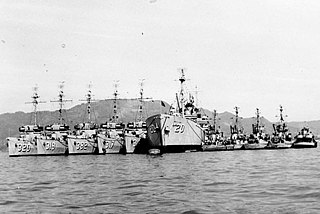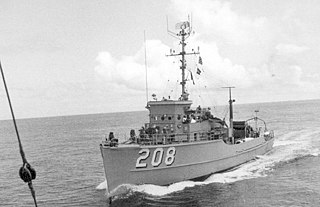
USS Naifeh (DE-352) was a John C. Butler-class destroyer escort in service with the United States Navy from 1944 to 1960. She was sunk as a target in 1966.

USS Surfbird (AM-383) was an Auk-class minesweeper built during World War II for the United States Navy. She was the only U.S. Navy ship named for the surfbird.

USS Redstart (AM-378/MSF-378) was an Auk-class minesweeper commissioned by the United States Navy for service in World War II. Her task, as a fleet minesweeper, was to clear mines as the fleet proceeded into battle areas.

USS Ruddy (AM-380) was an Auk-class minesweeper acquired by the U.S. Navy for the dangerous task of removing mines from minefields laid in the water to prevent ships from passing. She was the only U.S. Navy ship named for the North American ruddy duck.
USS Dextrous (AM-341) was an Auk-class minesweeper built for the United States Navy which served in World War II, the Korean War, and beyond. She was later transferred to the Republic of Korea Navy where she served as ROKS Koje (PCE-1003).
USS Swift (AM-122) was an Auk-class minesweeper acquired by the United States Navy for the dangerous task of removing mines from minefields laid in the water to prevent ships from passing.
USS Symbol (AM-123) was an Auk-class minesweeper acquired by the United States Navy for the dangerous task of removing mines from minefields laid in the water to prevent ships from passing.

USS Toucan (AM-387) was an Auk-class minesweeper acquired by the United States Navy for the dangerous task of removing mines from minefields laid in the water to prevent ships from passing. She was the only U.S. Navy ship named for the toucan, a brightly colored and easily tamed bird of the American tropics, characterized by its large but thin beak.
USS Ptarmigan (AM-376) was an Auk-class minesweeper acquired by the United States Navy for the dangerous task of removing mines from minefields laid in the water to prevent ships from passing. She was the only U.S. Navy ship named for the ptarmigan, a grouse with feathered feet, found in northern regions.

USS Impeccable (AM-320) was an Auk-class minesweeper built for the United States Navy during World War II. She was originally ordered as HMS Brutus (BAM-7) for the United Kingdom's Royal Navy under Lend-Lease, but was acquired and renamed by the United States Navy before construction began. She was commissioned in 1944 and served in the Pacific before being decommissioned in 1947. After the outbreak of hostilities in Korea, Impeccable was recommissioned in 1952 and served off Korea through 1952. She was decommissioned for the final time in October 1955 and placed in reserve. She was sold for scrapping in 1974.

USS Murrelet (AM-372) was an Auk-class minesweeper acquired by the United States Navy to remove mines from minefields laid to prevent ships from passing. She was the only U.S. Navy ship named for the murrelet, a small sea bird found chiefly on islands in the northern Pacific Ocean.

USS Shoveler (AM-382) was an Auk-class minesweeper acquired by the U.S. Navy for the dangerous task of removing mines from minefields laid in the water to prevent ships from passing.

USS Towhee (AM-388) was an Auk-class minesweeper acquired by the United States Navy for the dangerous task of removing mines from minefields laid in the water to prevent ships from passing.

USS Sprig (AM-384) was an Auk-class minesweeper acquired by the United States Navy for the dangerous task of removing mines from minefields laid in the water to prevent ships from passing.
The second USS Scoter (AM-381) was an Auk-class minesweeper acquired by the United States Navy for the dangerous task of removing mines from minefields laid in the water to prevent ships from passing. Scoter was named after the word "Scoter," which is a mercantile name retained during service in the United States Navy.

USS Gladiator (AM-319) was an Auk-class minesweeper acquired by the U.S. Navy for the dangerous task of removing mines from minefields laid in the water to prevent ships from passing.

The second USS Ardent (AM-340) was a Auk-class minesweeper in the United States Navy.
USS Spear (AM-322) was an Auk-class minesweeper acquired by the United States Navy for the dangerous task of removing mines from minefields laid in the water to prevent ships from passing.

USS Chief (AM-315) was an Auk-class minesweeper acquired by the United States Navy for the dangerous task of removing mines from minefields laid in the water to prevent ships from passing, and named after the word "chief," the head or leader of a group.

USS Widgeon (AMS/MSC-208) was a Bluebird-class minesweeper acquired by the US Navy for clearing coastal minefields.












